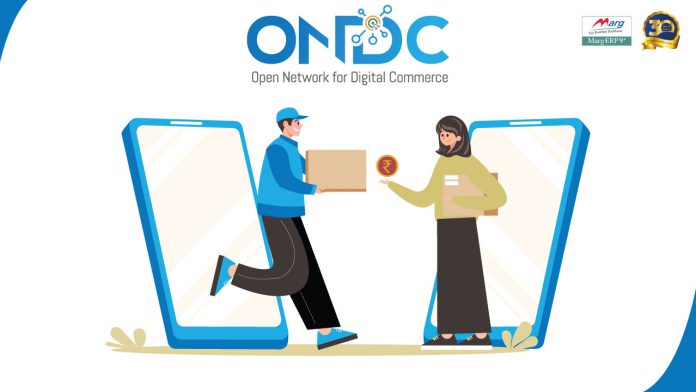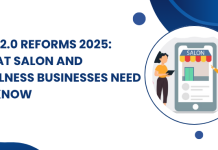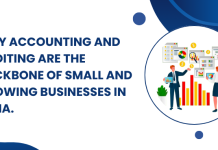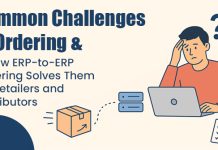The e-commerce landscape is continually evolving, adapting, and embracing newer technologies to ensure a seamless shopping experience for consumers. The rise of ONDC (Open Network for Digital Commerce) stands testament to this ever-evolving nature of e-commerce. In this blog, we’ll delve deep into understanding what ONDC is, its implications, and its anticipated future on platforms like Marg ERP.
What is ONDC?
ONDC, an acronym for Open Network for Digital Commerce, is a pioneering initiative aimed at promoting open networks for online commerce. Its foundation rests on standardizing and streamlining various e-commerce processes to ensure a unified experience for both sellers and buyers. By setting uniform protocols and ensuring open networks, ONDC seeks to democratize the digital commerce space, making it accessible and feasible for a broader spectrum of businesses, including the smaller players.
ONDC envisions an open and inclusive network where multiple e-commerce service providers can seamlessly connect and offer their services.
At its core, ONDC aims to address several key challenges faced by businesses and consumers in the digital commerce space:
- Interoperability: ONDC seeks to eliminate the silos that currently exist in the e-commerce sector by enabling different platforms, apps, and marketplaces to interoperate. This means that businesses can list their products and services on multiple e-commerce platforms simultaneously.
- Reduced Costs: ONDC is expected to significantly reduce the cost of doing business online, making it more accessible to small businesses. By eliminating the need for businesses to build custom integrations with each e-commerce platform, ONDC streamlines the process and reduces overhead costs.
- Data Ownership and Privacy: ONDC is designed to ensure that businesses have control over their data and customer information, reducing the reliance on large e-commerce platforms that may collect and monetize data.
How to Use ONDC?
The process of using ONDC is expected to be user-friendly and accessible for businesses of all sizes. Once fully operational, businesses can register on the ONDC platform and list their products or services. ONDC will provide standardized APIs (Application Programming Interfaces) that businesses can use to connect with various e-commerce service providers.
To use ONDC effectively, businesses will need to have an online presence, including a website or a mobile app. They can then use the ONDC APIs to integrate with multiple e-commerce platforms and manage their product listings, inventory, and orders from a central dashboard.
The Drive Behind ONDC E-Commerce:
Why is there a need for something like ONDC when there are already dominant players in the e-commerce landscape? The answer lies in creating an equal playing ground. Unlike traditional e-commerce platforms where they control the data, operations, and pricing to some extent, the open network digital commerce philosophy of ONDC ensures more transparent dealings.
ONDC and Marg ERP: The Synergy for Future Digital Commerce
The digital transformation in commerce, primarily driven by e-commerce platforms, has underscored the need for robust back-end solutions that can handle both the influx of online orders and the complexities of offline operations. While platforms like ONDC aim to reshape the e-commerce landscape in India, there is an equally strong need for ERP solutions that can integrate seamlessly with such platforms. This is where Marg ERP comes into play, bridging the gap between digital and physical commerce.
Marg ERP: India’s ERP Prodigy
Marg ERP is renowned in India for its comprehensive solutions catering to various business requirements – from inventory management, accounting, sales, and GST compliance. Predominantly, a large share of Marg ERP’s user base consists of Small and Medium Enterprises (SMEs) – the segment that often finds it challenging to integrate online operations into their traditional business model efficiently.
ONDC: An E-commerce Revolution
ONDC’s vision of creating an open, inclusive, and accessible digital commerce platform aligns well with the aspirations of numerous SMEs who seek a level playing field in the vast e-commerce landscape. As ONDC eliminates intermediaries and promotes a direct connection between sellers and consumers, it inherently supports the democratization of online commerce.
The Integration and its Advantages
When these two powerful entities – Marg ERP and ONDC – come together, they hold the potential to redefine how SMEs operate in the digital age:
- Efficient Inventory Management: One of the critical challenges for businesses, especially SMEs, is maintaining accurate inventory levels. Overstocking can lead to increased holding costs, while understocking can result in missed sales opportunities. By integrating Marg ERP with ONDC, businesses can leverage real-time data synchronization. This means the moment a product is sold online on the ONDC platform, the inventory level in Marg ERP is updated instantly, ensuring businesses always have an accurate picture of their stock levels.
- Unified Customer Experience: In today’s digital age, a fragmented customer experience can be detrimental to a brand’s reputation. Customers demand consistency, whether they are shopping in a physical store, browsing an online platform, or interacting with customer service. Marg ERP’s integration with ONDC ensures that businesses can provide a unified shopping experience. Prices, product availability, and promotions remain consistent, irrespective of where the customer chooses to engage with the brand.
- Enhanced Reach: One of the core benefits of e-commerce is the ability to reach a wider audience without geographical constraints. With ONDC’s democratized platform, even the smallest of vendors can showcase their products to a national audience. When Marg ERP users integrate with ONDC, they are not only streamlining their backend operations but also expanding their potential customer base manifold.
Open Network for Digital Commerce Apps:
With the digital revolution, apps are the way forward. ONDC online shopping is likely to spur the development of a plethora of Open Network for Digital Commerce apps, tailored to cater to niche market segments and offer personalized shopping experiences. These apps, aligned with the ONDC’s philosophy, will ensure a consistent, transparent, and standardized shopping journey for users.
Conclusion:
The rise of ONDC signifies a new era in the e-commerce domain. Its emphasis on open networks, standardization, and transparency can bring about a paradigm shift in how businesses operate online. For platforms like Marg ERP, ONDC offers new avenues for integration, making the management of both online and offline operations more streamlined. As ONDC continues to evolve, it’s poised to usher in a more inclusive, transparent, and fair e-commerce landscape in India.
Recommendations:
FAQs on ONDC:
Q. What does ONDC do?
ONDC, which stands for Open Network for Digital Commerce, is an initiative that promotes open networks for online commerce. It aims to standardize and streamline e-commerce processes, ensuring a unified experience for both sellers and buyers.
Q. Is ONDC available in India?
Yes, ONDC is a development aimed at reshaping the e-commerce landscape in India.
Q. How to use ONDC?
To use ONDC, businesses need to register on the ONDC platform and list their products or services. They will be provided with standardized APIs (Application Programming Interfaces) to connect with various e-commerce service providers. An online presence, like a website or mobile app, is also required.
Q. Is ONDC successful in India?
ONDC’s vision is to democratize the e-commerce sector in India, offering an open and inclusive network. It seeks to support SMEs and provide them with a level playing field in the vast e-commerce landscape. The actual measure of its success would be evident over time as more businesses adopt it.
Q. Is ONDC private or government?
The blog does not specify whether ONDC is a private or government initiative.
Q. Who owns ONDC in India?
The blog does not mention a specific owner or entity behind ONDC.
Q. What is the future of ONDC? ONDC’s future is poised to usher in a more inclusive, transparent, and fair e-commerce landscape in India. It will likely influence the development of various Open Network for Digital Commerce apps tailored for specific market segments.
Q. In which city is ONDC available?
ONDC, being an online platform, is accessible from any city in India, ensuring its wide reach and availability.
Q. How does ONDC differ from traditional e-commerce platforms?
Unlike traditional e-commerce platforms where they control the data, operations, and pricing to some extent, ONDC’s philosophy emphasizes open network digital commerce, ensuring transparent dealings and eliminating intermediaries. This promotes a direct connection between sellers and consumers.
Q. How does ONDC protect data ownership and privacy?
ONDC is designed to give businesses control over their data and customer information, reducing dependency on large e-commerce platforms that may otherwise collect and monetize this data.
Q. Can small businesses benefit from ONDC?
Absolutely. One of ONDC’s core visions is to democratize the digital commerce space. By reducing costs and removing the need for custom integrations with each e-commerce platform, ONDC makes online business more accessible and feasible for smaller players.
Q. What is the synergy between ONDC and Marg ERP?
Marg ERP and ONDC’s collaboration holds the potential to redefine how SMEs operate in the digital age. Integrating Marg ERP with ONDC allows businesses to manage inventory efficiently, provide a unified customer experience, and expand their reach.




















